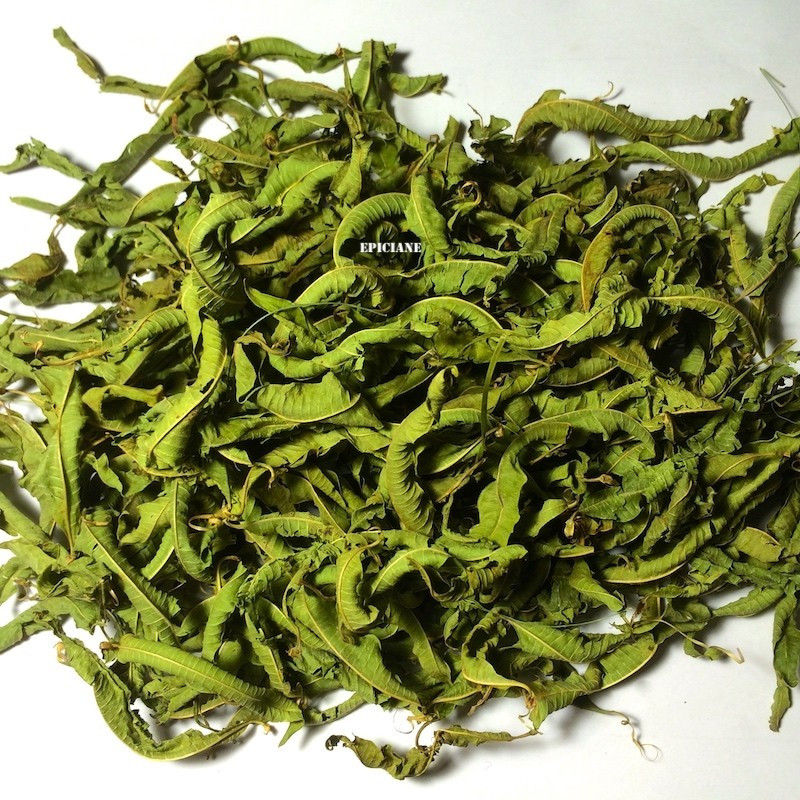
Reference: jasmin



Its taste is very pleasant, lemony and fresh.
Mainly used for herbal teas, it has a refreshing and digestive effect.
 Delivery
Delivery
Mondial Relay
 Returns
Returns
See conditions
 Payments
Payments
100% secure
Livré en sachet refermable
°°°
Uses in Cooking
There is often confusion between fragrant verbena (or lemon verbena), which is offered here, lemon balm (Melissa officinalis), and especially vervain (Verbena officinalis). This vervain, a wild plant from our regions, isn’t particularly appealing in taste but does have many benefits.
The leaves of the lemon verbena (or fragrant verbena) offered here are most commonly used in cold or hot herbal teas, either on their own or combined with other herbs like rosemary, mint, or enhanced with citrus fruits (bergamot or bitter orange peel). A digestive and calming evening tea can be made by mixing fragrant verbena, chamomile, mint, and orange blossom in equal parts. Steep about a teaspoon of this blend for 10 minutes in a bowl of boiling water.
But the delicate lemony flavor of these leaves also pairs well with fish (a few leaves added to the sauce or broth), marinades, poultry, stuffings, certain pastries, or desserts (a few leaves infused in hot milk, for example), refreshing ice creams, and even in certain vinegars (add the whole leaves to infuse).
Fragrant verbena is also commonly used, alone or with other herbs, in alcohols and liqueurs (as in our blend for vermouth).
Its lemony fragrance comes from the essential oil in its leaves, citral, widely used in perfumery and cosmetics as well as for scenting household products.
It is highly digestive, alleviating stomach discomfort, slightly sedative, soothing, calming, and promotes better sleep. It is recommended for treating depressive states, anxiety, and stress as it is also very energizing.
Who am I?
Origin: Morocco, Marrakech region
Scientific name: Aloysia citriodora Palau
Common names: lemon verbena, Peruvian verbena, three-leaved verbena, herb Louise, Indian verbena, Arab tea, and sometimes mistakenly just "lemongrass."
This lemon verbena, from the Verbenaceae family, is a deciduous plant that grows up to about 1 meter tall. Its woody stems and light green, highly fragrant, narrow lance-shaped leaves end in a point and grow in groups of three. Small, whitish, spike-like flowers, not particularly notable, appear in the summer but do not produce seeds, at least in our latitudes.
The plant originates from South America, mainly the Andes, Peru, Bolivia, Chile, Uruguay, and Bolivia, where it grows at altitudes between 2000 and 3000 meters. It has adapted well to the Mediterranean regions of southern France and Spain, including Morocco. In more northern regions, it is not hardy and needs to be brought indoors for winter.
A Little History
In Peru, verbena is used in the national soft drink, "Inca Kola," the country's best-selling beverage, far outpacing Coca or Pepsi! This highlights the pride locals have for this plant.
In 1767, Frenchman Philibert Commerson took a specimen from Buenos Aires during a journey with Bougainville. However, the plant had apparently already been discreetly imported to Madrid, Spain, by two professors who bequeathed it with its scientific name. One of its common names, "herb Louise," recalls Marie-Louise of Parma, wife of the owner of Madrid’s botanical garden, where these two professors planted it for the first time.
Data sheet
 Lydie S.
Lydie S.
Elle est parfaite pour mes préparations de tisane.

 Lydie S.
Lydie S.
Elle est parfaite pour mes préparations de tisane.

Reference: jasmin
Reference: rosepetale
Reference: SPW06600
Reference: badianeM
Reference: camomilleRom
Reference: badianeE
Reference: 00033929-0001
Reference: 10M6821604
Reference: 10N7738802
Reference: EPI230204
Reference: bergamote
Reference: 3913
Reference: 3N7137901
Reference: 050721
Reference: 108017302
Reference: cardamomeverteE
Reference: 6470
Reference: ecorcecitronH
Reference: 1N7004306

Its taste is very pleasant, lemony and fresh.
Mainly used for herbal teas, it has a refreshing and digestive effect.